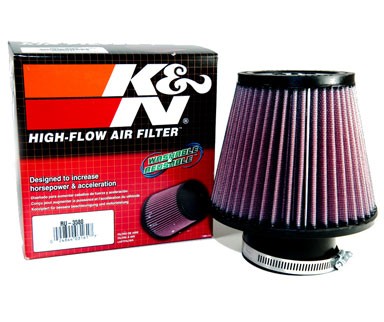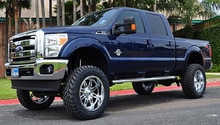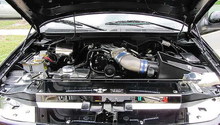Ford F-150/F-250: Air Intake Modifications
Swapping out the air intake for an aftermarket one is of the easiest, most immediately gratifying mods you can do to your F-150 or Super Duty. Choosing the intake you want, however, can be a challenge. Make it easier with this guide on intake types below.
This article applies to the Ford F-150 (2004-2014) and the Ford F-250, F-350 Super Duty (2005-2014).
So you want a little more power? Modifying the air intake is a good way to gain a bump in horsepower while keep the cost down. Air intakes improve performance by using a higher flowing filter. Intakes that are more free flowing bring in more air and make more power.
Most vehicles from factory will come with a cheap paper filter, while these keeps cost down, it restricts airflow and can clog up easily. The intake system will also come with also have some tight bends or curves that are there to help keep the sound down, but negatively impact airflow. The last drawback to the factory system is that a lot will draw air from inside the engine bay where the air is warm. By freeing the constriction in the system, your engine can get the oxygen it needs easier to burn fuel and therefore won't need to work as hard. The cooler air helps this effect as well since its more dense than the warm air found under the hood and denser air means more oxygen.
Both the Ford F-150 and the F-250 have similar setups for their air intakes regardless of engine type. An engine being gasoline or diesel does not make a difference in this case. Still, the variety of engine configurations and engine bays mean that prices and part numbers may fluctuate depending on your particular truck.
Pro Tip
A tune for you engine to compensate for the increased airflow will really help bring out the power and in some cases is needed to correct a lean code that can be generated by the added airflow.
Special Notes
- Since prices vary by both year and motor, all prices in this for parts will be based off a 2008 F-150 with the 4.6L V8. However the price difference brand to brand generally holds the same regardless of the vehicle.
High Flow Air Filters
The simplest way to upgrade your trucks air intake is to install a high-flow air filter. The normal filter element in an F-150 or Super Duty is very good at filtering air without requiring any maintenance, but it's also restrictive. After market filters will flow more air to your engine. There are two main varieties: oiled and dry. Oiled filters are generally made of cotton and are maintanable. When they get dirty you can simply wash them off and re-use them. Dry filters are made of paper. Aftermarket ones will still flow better than the stock units, but they will not flow as clean or as much air as an oiled filter.
Oiled Filters

DIY Cost – $45-60
Professional Cost – $25 for labor
Skill Level – Novice
Oiled filters are great when properly oiled, however can cause problems like dirtying the mass air flow sensor when not. The oil on the filter will trap more dirt and debris than a dry filter will at the sacrifice of a little less airflow. Majority of these are also cleanable and reusable where dry filters tend to be disposable instead. Brands to consider are AFE, AEM, and K&N.
Pro Tip
Maintainable filters are great, but be careful when cleaning and re-oiling them. Too high a hose pressure can ruin the fabric, so be careful while washing. If you over oil a filter, that oil can get sucked into the intake tract and onto the Mass Air Flow sensor. Your truck might behave strangely if the MAF is dirty.
Dry Filters

DIY Cost – $40-60
Professional Cost – $25 for labor
Skill Level – Novice
Dry filters are usually higher flowing than oiled filters and are less maintenance too. With these, you don't have to worry about over-oiling or when the next time you need to oil is. These tend to be disposable versus cleanable, but some of the nicer ones are still cleanable with an air compressor to blow out the dirt. Brands to consider are AFE, AEM, and K&N.
Air Intakes
Aftermarket air intakes add power by relocating the filter to a place on the truck with greater airflow. There are several general types of intakes which manufacturers like to market differently. Regardless of type a new intake will only add a handful of horsepower by themselves. Typically these are paired with an aftermarket engine tune that takes advantage of the extra air flow. The other thing they can add is a bit of roar to your engine and some style to you engine bay.
Long Ram

DIY Cost – $150-450
Professional Cost – $50-150 for labor
Skill Level – Novice to Intermediate depending on kit chosen
You don't see too many true long ram air intakes on the road today due to both their design and when they function the best. These function by literally forcing air into the intake through a forward facing (usually exposed) opening. Due to the design these really function best at speeds above 40 MPH to be able to pull in the most dense air. Because these require a forward facing opening, sometimes it will require a little modification to be able to install them properly.
Short Ram

DIY Cost – $60-200
Professional Cost – $50 for labor
Skill Level – Novice
Short ram air intakes offer benefits over the long ones. Ease of installation, more effectiveness at lower speeds, and a more stock appearance are a few of the benefits. However, they also have a few negatives when compared to the long ram style including not being able to draw as dense of air and taking in warmer air.
Cold Air Intakes

DIY Cost – $150-450
Professional Cost – $50-100 for labor
Skill Level – Novice
Cold air intakes are probably the best bet for the daily drivers out there instead of the ram air style of intake. These function by drawing in colder air from the outside of the engine bay versus the factory style that may draw air from inside the engine bay. These intakes will also use a larger, high flowing tube to help increase the air flow to the engine. You'll also notice that most will come with an air box around them to block out the engine heat. Unlike ram air intakes, these function well at all speeds because they aren't reliant on air speed.
Related Discussions
- What Is the Difference Between Ram Air and Cold Air Intake Systems? - Ebay.com
- Cold Air Intake - F150Forum.com
- Pros and Cons of a High Flowing Air Filter - CarsDirect.com






